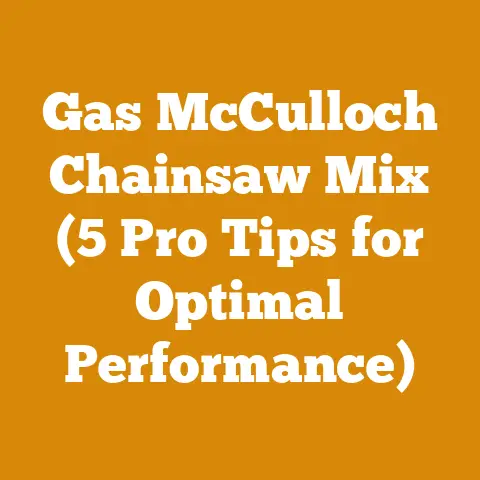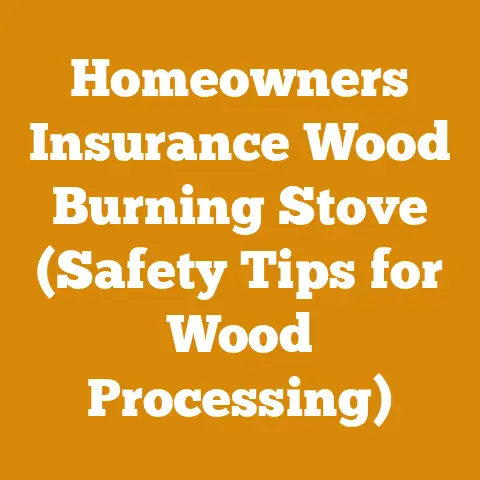Can You Burn Corn in Pellet Stove? (5 Pro Tips for Wood Heat)
The icy grip of winter is tightening, and the cost of heating oil is soaring like a hawk.
You’re staring at your pellet stove, a beacon of warmth in the impending freeze, and a question claws at the back of your mind: “Can I burn corn in this thing?” The allure of cheaper, readily available corn kernels is strong, but venturing into uncharted territory with your heating system can be a risky game.
I understand the temptation – I’ve faced similar dilemmas myself, trying to squeeze every last BTU out of my wood-burning setup while keeping my wallet from weeping.
Let’s dive deep into the world of alternative fuels and pellet stoves, separating fact from fiction and arming you with the knowledge to make the best decision for your home and your budget.
Can You Burn Corn in a Pellet Stove? (5 Pro Tips for Wood Heat)
The short answer?
It’s complicated.
While some pellet stoves are designed and approved to burn corn, many are not.
Simply tossing a bag of corn into your standard wood pellet stove is a recipe for disaster, potentially damaging your stove, voiding your warranty, and even creating a fire hazard.
But don’t despair!
There are ways to make corn burning work, and I’m here to guide you through the process, highlighting the pros, cons, and crucial considerations.
I’ll even share some hard-earned lessons from my own experiments with alternative fuels and how to avoid costly mistakes.
Understanding the Basics: Pellet Stoves and Fuel Types
Before we delve into the nitty-gritty of corn burning, let’s establish a solid foundation.
Pellet stoves are designed to burn small, compressed pellets made from various materials, most commonly wood.
These pellets are fed into the combustion chamber at a controlled rate, providing consistent and efficient heat.
The efficiency of a pellet stove hinges on the fuel’s BTU (British Thermal Unit) content, moisture content, and ash production.
- Wood Pellets: The gold standard, wood pellets are typically made from sawdust and wood shavings compressed into uniform cylinders.
They offer a good balance of heat output, low ash, and affordability.
Prices vary widely depending on wood species, pellet quality (premium vs.
standard), and location.
I’ve seen prices range from \$200 to \$400 per ton, with premium pellets generally costing more but burning cleaner and producing less ash. - Other Biomass Pellets: Beyond wood, pellet stoves can sometimes burn other biomass fuels like switchgrass, miscanthus, and even agricultural byproducts.
However, these fuels often require specialized stoves and careful monitoring. - Corn: Ah, the star of our show.
Corn, when burned correctly, can provide a significant amount of heat.
However, it also presents unique challenges, including higher ash content, potential for clinkering (the formation of hard, fused ash), and the need for specific stove modifications.
The Allure of Corn: Why Consider Burning It?
So, why would anyone consider burning corn in a pellet stove?
The answer, as always, boils down to cost and availability.
In regions where corn is readily available and relatively inexpensive, it can be a tempting alternative to wood pellets.
- Cost Savings: Depending on the local market, corn can be significantly cheaper than wood pellets, especially during harvest season.
I remember one year when wood pellet prices spiked due to a supply chain disruption.
Corn, on the other hand, was plentiful and selling for almost half the price.
It was a tempting proposition, but I knew I had to do my research before making the switch. - Renewable Resource: Corn is a renewable resource, and burning it can be considered carbon neutral, as the carbon released during combustion is offset by the carbon absorbed by the growing corn plants.
- High BTU Content: Corn boasts a relatively high BTU content, comparable to some types of wood pellets.
This means that, pound for pound, it can generate a similar amount of heat.
The Challenges of Corn: Why It’s Not Always a Simple Solution
While the potential benefits of burning corn are enticing, it’s crucial to understand the challenges.
Corn isn’t a “plug-and-play” fuel for most pellet stoves.
- Ash Content: Corn has a significantly higher ash content than wood pellets.
This means you’ll need to clean your stove much more frequently, potentially daily, to prevent ash buildup from clogging the combustion chamber and reducing efficiency. - Clinkering: The high ash content of corn can lead to clinkering, where the ash melts and fuses into hard, rock-like clumps.
These clinkers can be difficult to remove and can damage the stove’s components. - Stove Compatibility: Not all pellet stoves are designed to handle corn.
Burning corn in a stove that isn’t rated for it can damage the stove, void the warranty, and even create a fire hazard.
I’ve heard horror stories of augers jamming, burn pots melting, and stoves overheating due to improper corn burning. - Moisture Content: Corn needs to be dry to burn efficiently.
Ideally, it should have a moisture content of 12-15%.
Wet corn will burn poorly, produce excessive smoke, and potentially damage the stove. - Odor: Some people find the smell of burning corn unpleasant.
While I personally don’t mind it, it’s definitely something to consider.
It’s a slightly sweet, cornbread-like aroma that can permeate your home. - Storage: Corn needs to be stored in a dry, rodent-proof container to prevent spoilage and infestation.
I learned this the hard way when I stored a bag of corn in my garage and woke up one morning to find it riddled with mouse holes.
Pro Tip #1: Check Your Stove’s Manual and Warranty
This is the most important step.
Before you even think about buying a bag of corn, consult your pellet stove’s manual and warranty.
Look for specific information on approved fuel types.
If the manual explicitly states that the stove is not designed for corn, do not burn corn in it. Doing so could void your warranty and potentially damage your stove.
I once had a neighbor who ignored this advice and tried burning corn in his standard wood pellet stove.
Within a week, his auger was jammed, his burn pot was clogged with clinkers, and he was facing a hefty repair bill.
He ended up spending more money fixing his stove than he would have saved on fuel.
Pro Tip #2: Invest in a Corn-Capable Pellet Stove
If you’re serious about burning corn, the best option is to invest in a pellet stove specifically designed and approved for corn burning.
These stoves typically feature:
- Larger Burn Pots: To accommodate the higher ash content of corn.
- Agitators: To prevent clinkering and ensure even burning.
- More Powerful Augers: To handle the denser fuel.
- Adjustable Airflow Settings: To optimize combustion for corn.
These stoves are often more expensive than standard wood pellet stoves, but they’re a worthwhile investment if you plan to burn corn regularly.
I’ve seen corn-capable stoves range in price from \$2,000 to \$5,000, depending on size, features, and brand.
While the upfront cost is higher, the long-term benefits of efficient and safe corn burning can outweigh the initial investment.
Cost Considerations:
- Stove Purchase: \$2,000 – \$5,000 (One-time cost)
- Installation: \$200 – \$500 (One-time cost)
- Maintenance: Potentially higher due to the nature of corn (variable cost)
Data Point: According to the Pellet Fuels Institute, corn-burning stoves represent a small but growing segment of the pellet stove market, driven by the desire for alternative fuel options.
Pro Tip #3: Source High-Quality, Dry Corn
The quality of the corn you burn directly impacts its performance and the longevity of your stove.
Look for:
- Clean Corn: Free from debris, mold, and other contaminants.
- Dry Corn: With a moisture content of 12-15%.
Use a moisture meter to check the moisture content before burning.
I’ve found that a good moisture meter is an invaluable tool for anyone burning wood or corn. - Proper Storage: Store corn in a dry, rodent-proof container.
Cost Considerations:
- Corn Purchase: Prices vary widely depending on location and season.
I’ve seen prices range from \$5 to \$15 per 50-pound bag. - Moisture Meter: \$20 – \$50 (One-time cost)
- Storage Container: \$30 – \$100 (One-time cost)
Data Point: The USDA publishes regular reports on corn prices, providing valuable insights into market trends and regional variations.
Pro Tip #4: Adjust Your Stove Settings and Monitor Performance
Even with a corn-capable stove, you’ll need to adjust the stove settings to optimize combustion for corn.
This may involve adjusting the airflow, feed rate, and temperature settings.
Start with the manufacturer’s recommendations and then fine-tune the settings based on your stove’s performance.
- Start Small: Begin by mixing a small amount of corn with wood pellets and gradually increase the corn ratio as you gain experience.
- Monitor the Flame: A healthy corn flame should be bright yellow and consistent.
A smoky or sputtering flame indicates incomplete combustion. - Check the Ash: Regularly inspect the ash in the burn pot.
Excessive clinkering indicates that the stove settings need to be adjusted. - Clean Frequently: Clean your stove more frequently when burning corn, potentially daily, to prevent ash buildup.
My Personal Experience: When I first started experimenting with corn, I made the mistake of filling the hopper with 100% corn and setting the stove to the same settings I used for wood pellets.
The result was a smoky, inefficient fire that produced a mountain of ash.
I quickly learned that patience and careful monitoring are key to successful corn burning.
Pro Tip #5: Be Prepared for Increased Maintenance
Burning corn inevitably leads to increased maintenance.
The higher ash content means you’ll need to clean your stove more frequently, and the potential for clinkering means you’ll need to be vigilant about removing any hard ash clumps.
- Daily Cleaning: Empty the ash pot and scrape the burn pot daily.
- Weekly Inspection: Inspect the auger, combustion chamber, and venting system for ash buildup and clinkers.
- Annual Servicing: Have your stove professionally serviced annually to ensure it’s operating safely and efficiently.
Cost Considerations:
- Cleaning Supplies: Brushes, scrapers, ash vacuum (variable cost)
- Professional Servicing: \$100 – \$300 per year (annual cost)
Data Point: Regular maintenance is crucial for extending the lifespan of your pellet stove and preventing costly repairs.
Neglecting maintenance can lead to reduced efficiency, increased emissions, and even fire hazards.
A Deep Dive into Cost Factors: Wood vs. Corn
Let’s get down to brass tacks.
What are the actual costs associated with burning wood pellets versus corn?
This is where things get interesting, as prices fluctuate wildly depending on location, season, and availability.
I’ll share my insights based on years of experience and data gathered from various sources.
Wood Pellet Costs: A Regional Analysis
Wood pellet prices are influenced by several factors, including:
- Wood Species: Hardwood pellets (e.g., oak, maple) generally burn hotter and cleaner than softwood pellets (e.g., pine, fir).
- Pellet Quality: Premium pellets are made from higher-quality wood and undergo more rigorous processing, resulting in lower ash content and higher BTU output.
- Location: Prices vary depending on the proximity to pellet mills and the cost of transportation.
- Seasonality: Prices tend to be higher during the peak heating season (winter) due to increased demand.
Regional Examples:
- Northeast US: Prices typically range from \$250 to \$400 per ton for premium hardwood pellets.
- Midwest US: Prices tend to be lower, ranging from \$200 to \$350 per ton for standard wood pellets.
- Pacific Northwest US: Prices are generally similar to the Midwest, with a wider range of options available due to the abundance of wood resources.
- Europe: Prices vary significantly depending on the country, with some countries offering government subsidies for wood pellet heating.
Data Point: According to the US Energy Information Administration (EIA), the average residential price of wood pellets in the US has fluctuated significantly over the past decade, reflecting changes in supply, demand, and production costs.
Corn Costs: A Volatile Market
Corn prices are even more volatile than wood pellet prices, as they’re heavily influenced by agricultural factors such as weather patterns, crop yields, and government subsidies.
- Local Availability: The closer you are to corn-producing regions, the lower the price is likely to be.
- Harvest Season: Prices tend to be lowest during and immediately after the harvest season (fall).
- Storage Costs: Storing corn can add to the overall cost, as you need to protect it from moisture, pests, and spoilage.
Regional Examples:
Calculating the Cost per BTU: A Comparative Analysis
To truly compare the cost-effectiveness of wood pellets and corn, we need to calculate the cost per BTU.
This involves dividing the cost per unit of fuel (e.g., per ton or per bag) by the BTU content of that fuel.
- Wood Pellets: Premium hardwood pellets typically have a BTU content of around 8,000 BTU per pound.
At a price of \$300 per ton, the cost per BTU is approximately \$0.019 per 1,000 BTU.- Calculation: (\$300 / 2,000 lbs) / 8,000 BTU/lb = \$0.01875 per 1,000 BTU
- Corn: Corn typically has a BTU content of around 7,000 BTU per pound.
At a price of \$10 per 50-pound bag, the cost per BTU is approximately \$0.029 per 1,000 BTU.- Calculation: (\$10 / 50 lbs) / 7,000 BTU/lb = \$0.02857 per 1,000 BTU
Important Note: These are just examples.
The actual cost per BTU will vary depending on the specific prices and BTU content of the fuels in your area.
The Verdict: In this example, wood pellets are actually cheaper than corn on a BTU basis.
However, this may not always be the case.
It’s crucial to perform your own calculations based on local prices to determine the most cost-effective option for your home.
Beyond the Fuel Cost: Considering Hidden Expenses
When comparing the costs of wood pellets and corn, it’s important to consider the hidden expenses that can impact the overall cost-effectiveness.
- Increased Maintenance: As mentioned earlier, burning corn leads to increased maintenance, which can add to the overall cost.
- Stove Repairs: Burning corn in a stove that isn’t designed for it can lead to costly repairs.
- Storage Costs: Storing corn requires a dry, rodent-proof container, which can add to the overall cost.
- Time Investment: Cleaning your stove more frequently and adjusting the settings can take up a significant amount of time.
My Advice: Factor in these hidden expenses when calculating the true cost of burning corn.
Don’t just focus on the fuel price; consider the long-term impact on your stove and your time.
Step 1: Estimate Your Heating Needs
The first step is to estimate your heating needs.
This involves determining how much fuel you’ll need to burn to keep your home warm throughout the heating season.
- Calculate BTU Requirements: Use online calculators or consult with a heating professional to estimate the BTU requirements for your home based on its size, insulation, and climate.
- Track Fuel Consumption: Monitor your fuel consumption over time to get a more accurate estimate of your heating needs.
- Consider Weather Patterns: Factor in the expected weather patterns for the upcoming heating season.
A colder-than-average winter will require more fuel.
My Approach: I keep a detailed log of my fuel consumption each year, noting the temperature, the amount of fuel burned, and any other relevant factors.
This helps me to refine my estimates and plan accordingly.
Step 2: Research Fuel Prices and Availability
Once you know how much fuel you’ll need, it’s time to research fuel prices and availability in your area.
- Contact Local Suppliers: Get quotes from multiple suppliers for wood pellets and corn.
- Check Online Marketplaces: Explore online marketplaces for potential deals.
- Consider Bulk Purchases: Buying fuel in bulk can often save you money.
- Factor in Delivery Costs: Don’t forget to factor in delivery costs when comparing prices.
My Tip: I always try to buy my fuel during the off-season when prices are typically lower.
I also look for suppliers who offer discounts for bulk purchases.
Step 3: Factor in Maintenance and Repair Costs
As we’ve discussed, maintenance and repair costs are an important part of budgeting for wood heat.
- Estimate Cleaning Supply Costs: Budget for cleaning supplies such as brushes, scrapers, and ash vacuums.
- Set Aside Funds for Repairs: Set aside funds for potential repairs to your stove.
- Schedule Annual Servicing: Schedule annual servicing to prevent costly problems.
My Strategy: I set aside a small amount of money each month specifically for stove maintenance and repairs.
This helps me to avoid unexpected financial burdens.
Step 4: Create a Budget Spreadsheet
The best way to manage your wood heat budget is to create a spreadsheet that tracks all of your expenses.
- List All Expenses: List all of your expenses, including fuel costs, maintenance costs, and repair costs.
- Track Actual Spending: Track your actual spending throughout the heating season.
- Compare Budget vs.
Actual: Compare your budget to your actual spending to identify areas where you can save money. - Adjust Your Budget as Needed: Adjust your budget as needed based on your actual spending and any changes in fuel prices or weather patterns.
My Spreadsheet: My budget spreadsheet includes columns for estimated fuel consumption, actual fuel consumption, estimated fuel cost, actual fuel cost, maintenance costs, repair costs, and total expenses.
I also include a section for notes where I can track any relevant information.
Step 5: Explore Cost-Saving Strategies
Finally, explore cost-saving strategies to reduce your overall heating costs.
- Improve Home Insulation: Improving your home’s insulation can significantly reduce your heating needs.
- Seal Air Leaks: Sealing air leaks around windows and doors can also help to reduce your heating needs.
- Use a Programmable Thermostat: A programmable thermostat can help you to save energy by automatically adjusting the temperature when you’re not home.
- Burn Fuel Efficiently: Burn fuel efficiently by following the manufacturer’s recommendations for your stove and adjusting the settings as needed.
My Experience: I invested in improving my home’s insulation a few years ago, and it made a huge difference in my heating costs.
I also sealed air leaks around my windows and doors, which further reduced my energy consumption.
Actionable Takeaways and Next Steps
So, can you burn corn in a pellet stove?
The answer is a qualified “yes,” but only if you do your homework, invest in the right equipment, and are prepared for the increased maintenance.
Here are some actionable takeaways and next steps:
- Consult Your Stove’s Manual: This is the most important step.
Make sure your stove is approved for corn burning. - Consider a Corn-Capable Stove: If you’re serious about burning corn, invest in a stove specifically designed for it.
- Source High-Quality, Dry Corn: The quality of the corn you burn directly impacts its performance.
- Adjust Your Stove Settings: Fine-tune the settings to optimize combustion for corn.
- Be Prepared for Increased Maintenance: Burning corn inevitably leads to more frequent cleaning.
- Calculate the Cost per BTU: Compare the cost of wood pellets and corn on a BTU basis to determine the most cost-effective option.
- Create a Detailed Budget: Track all of your heating expenses to manage your costs effectively.
- Explore Cost-Saving Strategies: Improve your home’s insulation, seal air leaks, and burn fuel efficiently.
Next Steps:
- Research Corn-Burning Stoves: Explore different models and compare features and prices.
- Contact Local Suppliers: Get quotes for wood pellets and corn in your area.
- Invest in a Moisture Meter: This is an essential tool for anyone burning wood or corn.
- Start Small: Experiment with burning a small amount of corn mixed with wood pellets to see how your stove performs.
- Monitor Your Stove’s Performance: Keep a close eye on your stove and adjust the settings as needed.
Burning corn in a pellet stove can be a viable option for some homeowners, but it’s not a decision to be taken lightly.
By carefully considering the pros, cons, and costs involved, you can make an informed decision that’s right for your home and your budget.
Remember, safety and efficiency should always be your top priorities.
And if you’re ever in doubt, consult with a qualified heating professional.






